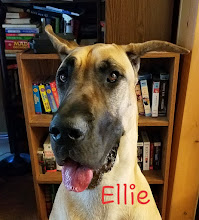Intro: "Rally" refers to Rally Obedience, which is sort of a hybrid of regular Obedience and Agility. The Agility influence is seen in the structure: Rally classes consist of unique courses designed by the judge. But instead of lots of jumps, tunnels and other obstacles, the elements of the course consist of different Obedience exercises. Some of these exercises are identical (or nearly identical) to required movements in regular Obedience. Many of them however, are based on training exercises (sometimes referred to as "doodles") used by trainers to help polish a team's Obedience performance. These training exercises may be designed to help perfect a dog's Heeling position, or Finishes, or Fronts or some other required performance.
In Rally competition, signs are used to tell the handler what exercise to perform. The handler follows the signs in order around the course. In Rally, the judge only gives the team one command: After asking "Are you ready?" (and getting an affirmative answer from the handler) the judge says "Forward". After that, the handler is on her own, and must rely on an understanding of all the Rally signs to know what to do.
In AKC Rally (which is what this series will focus on) there are 3 classes:
- Novice. The dog is shown on lead for the entire course. The course will consist of 10 to 15 exercise stations (not counting START and FINISH). There are no jumps in Novice.
- Advanced. After the dog has earned the Rally Novice title (done by earning at least 3 qualifying scores) you may show in Advanced. In Advanced, the dog is shown off lead for the entire course, and the course will consist of between 12 to 17 exercise stations. This will also include some exercise signs that cannot be used on a Novice course. (more about that in the next installment). There is one jump on every Advanced course.
- Excellent. After you've completed a Rally Advanced title, you may enter Excellent. This is also done off lead, and will consist of between 15 to 20 exercise stations. There are two jumps in every Excellent course.
Since it is so important for the handler to have a really good understanding of the Rally signs, this series is going to focus on explaining what the different Rally signs mean. Some of them are really quite self-explanatory, but many are quite confusing.
However, since this is the very start I'm going to explain some basic Obedience terms to be sure everyone knows what I'm talking about. Part 2 will start talking about specific Rally signs, so if you are already experienced with basic Obedience you can skip forward now :-)
Heel position:
Officially, the AKC Rules state that "The heel position as defined in these regulations applies whether the dog is sitting, standing, lying down or moving at heel. The dog should be at the handler's left side straight in line with the direction the handler is facing. The area from the dog's head to shoulder is to be in line with the handler's left hip. The dog should be close to, but not crowding, its handler so that the handler has freedom of motion at all times."
Sounds simple, doesn't it? But it takes a lot of practice to get it right. While it is true that the same level of perfection is not required in Rally as in regular Obedience, the dog and handler MUST still be able to work together as a team, and the dog should be able to stay reasonably close to the handler's left side throughout all the exercises (except when the handler is required to leave the dog's side to complete the exercise).
A good obedience class is the best way to learn how to teach your dog to Heel, but there are also many articles and videos online about teaching Heel position (Google "Heel position dog obedience"). One good one about how to start teaching this basic skill is here:
http://www.onlinedogcoach.com/index/lessons/competition-obedience-fundamentals/heel-on-left-obed
Front:
From the AKC Rules: the dog should "sit straight, centered in front of the the handler. The dog must be close enough to its handler so that the handler could touch its head without excessive bending, stretching or moving either foot." The Front is the position the dog should usually take after being called by the handler.
Finish:
This term describes the movement the dog must make to get from "Front" back to "Heel position". There are two ways the dog may do this: either by going to the handler's Right, around behind the handler and to the handler's left side; or by swinging around on the handler's Left and then sitting on the handler's left side. Ideally, the Finish movement should be performed "briskly" by the dog.
More about getting started in Rally is here:
http://classic.akc.org/events/rally/getting_started.cfm
The full Obedience and Rally regulations are here:
https://images.akc.org/pdf/rulebooks/RO2999.pdf
Here is a picture of Teddy and me doing an Advanced Rally course, which is why he's off lead - in Novice the dog stays on lead the whole time. You can't read any of the signs in this photo, but you can see the back of one in front of my right foot, and another next to the orange cone on the far left in the photo. Rally signs may be held up by anything that works - sticking them to a cone is pretty common in my area, but for this course sections of PVC pipe was used (with slots cut in to fit the signs). Wire holders are often used too. As long as the handler can see the signs, it will work.










No comments:
Post a Comment